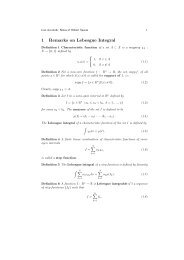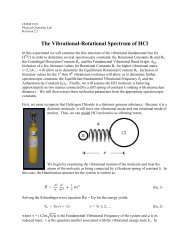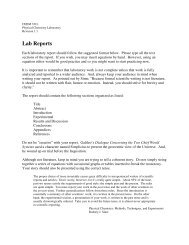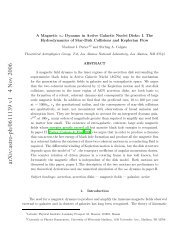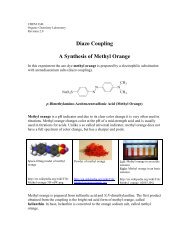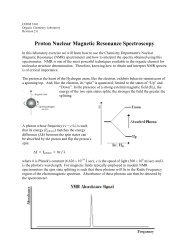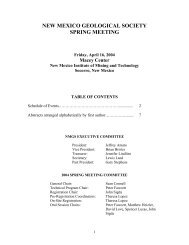Reservoir Rock & Source Rock Types: Classification, Properties ...
Reservoir Rock & Source Rock Types: Classification, Properties ...
Reservoir Rock & Source Rock Types: Classification, Properties ...
You also want an ePaper? Increase the reach of your titles
YUMPU automatically turns print PDFs into web optimized ePapers that Google loves.
PETR 571<br />
Week 3- notes<br />
<strong>Reservoir</strong> <strong>Rock</strong> & <strong>Source</strong> <strong>Rock</strong> <strong>Types</strong>: <strong>Classification</strong>,<br />
<strong>Properties</strong> & Symbols<br />
<strong>Reservoir</strong> rock: A permeable subsurface rock that contains petroleum. Must be both porous and permeable.<br />
<strong>Source</strong> rock: A sedimentary rock in which petroleum forms.<br />
• <strong>Reservoir</strong> rocks are dominantly sedimentary (sandstones and carbonates); however, highly<br />
fractured igneous and metamorphic rocks have been known to produce hydrocarbons, albeit on a<br />
much smaller scale<br />
• <strong>Source</strong> rocks are widely agreed to be sedimentary<br />
• The three sedimentary rock types most frequently encountered in oil fields are shales, sandstones,<br />
and carbonates<br />
• Each of these rock types has a characteristic composition and texture that is a direct result of<br />
depositional environment and post-depositional (diagenetic) processes (i.e., cementation, etc.)<br />
• Understanding reservoir rock properties and their associated characteristics is crucial in<br />
developing a prospect<br />
1
PETR 571<br />
Week 3- notes<br />
==================================================================================<br />
• Sandstones<br />
• Conglomerates<br />
• Halite (rock salt)<br />
• Gypsum<br />
• Anydrite<br />
• Limestone<br />
• Chalk<br />
• Coquina<br />
• Coal<br />
Different Forms of Sedimentary <strong>Rock</strong>:<br />
2
PETR 571<br />
Week 3- notes<br />
==================================================================================<br />
3
PETR 571<br />
Week 3- nootes<br />
======== =========== =========== =========== ============ =========== =========== =========== ====<br />
DDescription:<br />
Prroperties:<br />
HHistory:<br />
OOccurrence:<br />
Schematic<br />
illustratingg<br />
the three distinctive<br />
sedimeentary<br />
rocks, saandstone,<br />
shalee,<br />
and limestonne,<br />
and gra adations of eacch.<br />
• Distinc ctively dark-broown<br />
to black inn<br />
color (occasiionally<br />
a deep ddark<br />
green), occcasionally<br />
darrk<br />
gray, with w smooth latteral<br />
surfaces (nnormal<br />
to depoositional<br />
directtion)<br />
and irreguular<br />
vertical surrfaces<br />
(paralle el to depositionnal<br />
direction)<br />
• Compo osed of clay and<br />
silt-sized parrticles<br />
(q.v., weeek<br />
2 notes)<br />
• Clay pa articles are platy<br />
and orient thhemselves<br />
normmal<br />
to inducedd<br />
stress (overbuurden);<br />
this<br />
contrib butes to shale’ss<br />
characteristicc<br />
permeability<br />
• Behave e as excellent sseals<br />
Shales -- <strong>Source</strong><br />
<strong>Rock</strong>s and<br />
Seals:<br />
• Widely y regarded to be<br />
the main souurce<br />
of hydrocaarbons<br />
due to ooriginal<br />
composition<br />
being ricch<br />
in<br />
organic cs<br />
• A weak k rock highly ssusceptible<br />
to wweathering<br />
andd<br />
erosion<br />
• Deposi ited on river flooodplains,<br />
deepp<br />
oceans, lakess,<br />
or lagoons<br />
• The mo ost abundant seedimentary<br />
rocck<br />
(about 42%) )<br />
4
PETR 571<br />
Week 3- notes<br />
Geologic Symbol:<br />
• Horizontal, evenly-spaced dashed lines<br />
Standard basic geologic symbol for shale. May be modified<br />
to illustrate further detail.<br />
*For a complete version of the Standard Geologic Map Symbolization refer to<br />
URL: http://ngmdb.usgs.gov/fgdc_gds/geolsymstd/download.php<br />
==================================================================================<br />
Description:<br />
Sandstones and Sandstone <strong>Reservoir</strong>s:<br />
• Composed of sand-sized particles (q.v., week 2 notes)<br />
• Recall that sandstones may contain textural features indicative of the environment in which they<br />
were deposited: ripple marks (alluvial/fluvial), cross-bedding (alluvial/fluvial or eolian), gradedbedding<br />
(turbidity current)<br />
• Typically light beige to tan in color; can also be dark brown to rusty red<br />
<strong>Classification</strong>:<br />
• Sandstones can be further classified according to the abundance of grains of a particular chemical<br />
composition (i.e., common source rock); for example, an arkosic sanstone (usually abbreviated:<br />
ark. s.s.) is a sandstone largely composed of feldspar (feldspathic) grains….Can you recall which<br />
continental rock contains feldspar as one of its mineral constituents???<br />
• Sandstones composed of nearly all quartz grains are labeled quartz sandstones (usually<br />
abbreviated: qtz. s.s.)<br />
<strong>Properties</strong>:<br />
• Sandstone porosity is on the range of 10-30%<br />
• Intergranular porosity is largely determined by sorting (primary porosity)<br />
• Poorly indurated sandstones are referred to as fissile (easily disaggregated when scratched),<br />
whereas highly indurated sandstones can be very resistant to weathering and erosion<br />
5
PETR 571<br />
Week 3- notes<br />
History:<br />
• Sandstones are deposited in a number of different environments. These can include deserts (e.g.,<br />
wind-blown sands, i.e., eolian), stream valleys (e.g., alluvial/fluvial), and coastal/transitional<br />
environments (e.g., beach sands, barrier islands, deltas, turbidites)<br />
• Because of the wide variety of depositional environments in which sandstones can be found, care<br />
should be taken to observe textural features (i.e., grading, cross-bedding, etc.) within the reservoir<br />
that may provide evidence of its original diagenetic environment<br />
• Knowing the depositional environment of the s.s. reservoir is especially important in determining<br />
reservoir geometry and in anticipating potentially underpressured (commonly found in channel<br />
sandstones) and overpressured reservoir conditions<br />
Occurrence:<br />
• Are the second most abundant (about 37%) sedimentary rock type of the three (sanstones, shales,<br />
carbonates), the most common reservoir rock, and are the second highest producer (about 37%)<br />
Geologic Symbol:<br />
• Dots or small circles randomly distributed; to include textural features, dots or circles may be<br />
drawn to reflect the observation (for example, cross-bedding)<br />
Case example:<br />
.. . . . . . . . . . . . . . . . . … . . … . ….<br />
.. . . . . .. . … .. … .. . . . . . . . … . . … .<br />
. . .. . . . . . . . . . . . . . . . . …. . .<br />
… . . . . .. . … .. … .. . . . . . . ….. . . . .<br />
. . .. . . . . . . . . . . . . . . . . .. … …<br />
. … .. …… . .. … …. ….. .. . . . …. . …. . ..<br />
Standard geologic map symbol for sandstone. May<br />
be modified to illustrate further detail.<br />
• The Bartlesville Shoestring Sands are home to the Sallyards and Lamont Oil Field which is a<br />
classic Pennsylvanian shoreline sand reservoir (very similar, and in fact, difficult to distinguish<br />
from a stream valley reservoir). These ovular, lens shaped sands are situated in southern Kansas.<br />
6
PETR 571<br />
Week 3- nootes<br />
Bartlesville Shoestring Sannds:<br />
Cross-section and Regional Map<br />
7
PETR 571<br />
Week 3- nootes<br />
======== =========== =========== =========== ============ =========== =========== =========== ====<br />
DDescription:<br />
• Grains (clasts) are larrgely<br />
the skelettal<br />
or shell remmains<br />
of shalloww<br />
marine dwellling<br />
organismss,<br />
varying g in size and shhape,<br />
that eitheer<br />
lived on the oocean<br />
bottom ( (benthic) or flooated<br />
in water<br />
column n (neritic)<br />
• Many of o these clasts can be identified<br />
by skilled ppaleontologists<br />
and micropaleeontologists<br />
annd<br />
can<br />
be used d for correlativve<br />
purposes or aage<br />
range datinng;<br />
also benefi ficial in establisshing<br />
index fosssils<br />
for mar rker beds usedd<br />
in regional strratigraphic<br />
corrrelations<br />
• Dolom mites are a produuct<br />
of solution recrystallizatioon<br />
of limestonnes<br />
• Usually y light or dark gray, abundannt<br />
fossil molds aand<br />
casts, vugggy<br />
(vugular) poorosity<br />
C<strong>Classification</strong>:<br />
Carbonates annd<br />
Carbonate R<strong>Reservoir</strong>s:<br />
• Divided<br />
into limestonnes<br />
(calcium caarbonate<br />
-- CaCCO3<br />
) and doloomites<br />
(calciumm<br />
magnesium<br />
carbonate<br />
– CaMg(COO3)2<br />
)<br />
• Limest tones can be divided<br />
further into<br />
Mudstoness,<br />
Wackestoness,<br />
Packstones, Grainstones, annd<br />
Bounds stones accordinng<br />
to the limesstones<br />
depositioonal<br />
texture; seee<br />
Dunham claassification<br />
schheme<br />
DDunham<br />
classifi ication schemee<br />
of limestoness<br />
based on depoositional<br />
texturres.<br />
8
PETR 571<br />
Week 3- notes<br />
<strong>Properties</strong>:<br />
History:<br />
Case example:<br />
• Porosity is largely a result of dissolution and fracturing (secondary porosity)<br />
• Carbonates such as coquina are nearly 100% fossil fragments (largely primary porosity)<br />
• Are characteristically hard rocks, especially dolomite<br />
• Susceptible to dissolution weathering<br />
• Limestone reservoirs owe their origin exclusively to shallow marine depositional environments<br />
(lagoons, atolls, etc)<br />
• Limestone formations slowly accumulate when the remains of calcareous shelly marine organisms<br />
(brachiopods, bivalves, foramaniferans) and coral and algae living in a shallow tropical<br />
environment settle to the ocean bottom<br />
• Over large geologic time scales these accumulations can grow to hundreds of feet thick (El<br />
Capitan, a Permian reef complex, in West Texas is over 600 ft thick)<br />
Occurrence:<br />
• Are the least geologically abundant (about 21%) of the three (shales, sandstones, carbonates), but<br />
the highest producer (about 61.5%)<br />
Geologic Symbol:<br />
• Limestone – layers of uniform rectangles, each layer offset from that above it.<br />
• Dolomite – layers of uniform rhomboids, each layer offset from that above it.<br />
Standard geologic map symbols for limestone (left) and dolomite (right). May<br />
be modified to illustrate further detail.<br />
• The Golden Lane oil field is a prime example of a very large carbonate reservoir that has enjoyed<br />
a very productive life. It is an ancient (Cretaceous) atoll karst limestone encircling the Mexican<br />
city Tuxpan, both on and off shore.<br />
9
PETR 571<br />
Week 3- nootes<br />
Golden Lane Oil Field: Regioonal<br />
Map and Sequential Cross-sections<br />
10
PETR 571<br />
Week 3- nootes<br />
======== =========== =========== =========== ============ =========== =========== =========== ====<br />
Regression:<br />
The<br />
Sea’s retreat from the land. .<br />
•<br />
•<br />
•<br />
•<br />
Transgresssions<br />
and Regreessions<br />
in the SSedimentary<br />
CColumn<br />
Tr Transgression: The advancemment<br />
of seas onnto<br />
the land.<br />
The transgreession/regressioon<br />
cycle is preserved<br />
in the roock<br />
record by a repeating<br />
sequence of sandstones, shhales,<br />
and limesstones<br />
(a patterrn<br />
common in the stratigraphhic<br />
column)<br />
Indicative off<br />
Coastal (transsitional)/<br />
Marinne<br />
depositional<br />
environment<br />
Sands are deeposited<br />
near shhore;<br />
muds aloong<br />
continentall<br />
shelf; and maarine<br />
organismss<br />
on<br />
deep ocean bbottom<br />
This deposittional<br />
trend of sediments gradding<br />
outward mmoving<br />
away frrom<br />
the shoreliine<br />
and toward tthe<br />
deep oceann<br />
is called a faccies<br />
change<br />
11
PETR 571<br />
Week 3- nootes<br />
A schematic<br />
of faciess<br />
changes in neear-shore<br />
off-shhore<br />
depositionnal<br />
environmennts.<br />
•<br />
•<br />
•<br />
•<br />
•<br />
As the sea leevel<br />
advances aand<br />
retreats a ssuccession<br />
of ffacies<br />
changes are deposited aatop<br />
one another but are offset aaccording<br />
to thhe<br />
relative movvement<br />
of the wwater<br />
level at thhe<br />
time of depoosition<br />
This successsion<br />
of depositiion<br />
will result in a vertical seequence<br />
of rockk<br />
similar to thee<br />
lateral gradaation<br />
in a faciess<br />
change<br />
A sequence of sedimentaryy<br />
rock fining uppward<br />
would iindicate<br />
a transsgression<br />
(i.e.,<br />
sandstone ovverlain<br />
with shhale<br />
overlain with<br />
limestone)<br />
A sequence of sedimentaryy<br />
rock coarseniing<br />
upward woould<br />
indicate a regression (i.ee.,<br />
limestone ovverlain<br />
with shale<br />
overlain wiith<br />
sandstone)<br />
Pinch-outs aand<br />
interfingeriing<br />
of facies caan<br />
potentially pprovide<br />
stratigrraphic<br />
traps forr<br />
hydrocarbonns<br />
(and frequenntly<br />
do)<br />
12
PETR 571<br />
Week 3- nootes<br />
Marine Transgresssion/Regression<br />
Sequence<br />
13
PETR 571<br />
Week 3- nootes<br />
Case Exammple:<br />
Glossary:<br />
• The fol llowing figure is a classic Terrtiary<br />
transgresssion/regressioon<br />
cycle on the Gulf Coast<br />
of Texa as. Many like it are observedd<br />
around the world.<br />
Anhydritee:<br />
An evaporat te mineral of caalcium<br />
sulfate. .<br />
Arenite: CConsolidated,<br />
clastic c rock of sand sized partticles:<br />
arkose, sandstone, etcc.<br />
Argillaceoous:<br />
Shaly, or containing clayyey<br />
constituennts.<br />
Arkose: CCoarse-grained,<br />
feldspathic, vvariably<br />
sorted sandstone conntaining<br />
angulaar<br />
grains, repressenting<br />
rapid<br />
deposition and limited gr rain transport.<br />
Boundstonne:<br />
Sedimenta ary carbonate roock<br />
the originaal<br />
components of which weree<br />
bound togetheer<br />
in place duriing<br />
deposition:<br />
most algal ba ank and reef deeposits.<br />
Calcarenitte:<br />
A clastic li imestone compprising<br />
over 50 percent sand-ssize<br />
calcium caarbonate<br />
particcles<br />
cemented aas<br />
a<br />
calcareous sandstone.<br />
Calcareouus:<br />
<strong>Rock</strong> or oth her material coontaining<br />
up to 50 percent callcium<br />
carbonatte.<br />
14
PETR 571<br />
Week 3- notes<br />
Carbonate: <strong>Rock</strong>-forming minerals containing the carbonate ion which include calcite and dolomite.<br />
Carbonate mud: Usually precipitated lime mud: calcium carbonate mud without reservoir or source potential.<br />
Carbonate platform: A substantial limestone or dolomite substrate upon which a reef might be built.<br />
Chalk: Fine-textured marine limestone formed by shallow water accumulation of calcareous remains of floating<br />
micro-organisms and algae.<br />
Clast: A grain or fragment.<br />
Coral: Warm water, sessile, commonly calcareous, bottom-dwelling marine invertebrate animal. Colonial corals<br />
build coral reefs and banks.<br />
Coralline limestone: Limestone composed of coral constituents.<br />
Dolomite: Calcium magnesium carbonate: CaMg(CO3)2<br />
Dolomitization: A volume-reducing recrystallization process which adds the magnesium ion to calcium carbonate<br />
to form dolomite: can occur contemporaneously with deposition or diagenetically.<br />
Evaporite: A rock or mineral deposited by precipitation during evaporation.<br />
Facies: <strong>Rock</strong> type: lithology.<br />
Facies change: Change of one rock type to another time-correlative rock type.<br />
Formation: A discrete rock unit with characteristics suitable for distinctive study and mapping.<br />
Grainstone: A grain-supported carbonate rock with less than one percent intergranular mud.<br />
Group: A rock unit ronking above formation and comprising several formations.<br />
Gypsum: Hydrous calcium sulfate.<br />
Halite: <strong>Rock</strong> salt which consists of sodium chloride.<br />
Index fossil: A fossil that is diagnostic of a specific geologic age or range.<br />
Induration: Transformation of sediment to rock: lithification, diagenesis.<br />
Intergranular: Between the grains of a rock.<br />
Laminae: Thin layers of fine-grained sediment.<br />
Layer: A thickness of rock. A stratum.<br />
Limestone: Lithified calcium carbonate CaCO3<br />
Matrix (sedimentary): Fine-grained silt or clay material infilling intergranular sedimentary pore space between<br />
coarse grains.<br />
Member: A time-rock stratigraphic unit of which several can comprise a formation.<br />
15
PETR 571<br />
Week 3- notes<br />
Mud (sediment): A mixture of silt and /or clay particles and water. Diagenetically transformed into siltstone<br />
and/or shale.<br />
Oolite: A sedimentary rock comprising concentrically precipitated calcium carbonate ooliths approximately one<br />
mm in diameter.<br />
Oolitic limestone: A limestone, comprising calcareous ooliths, often having good reservoir potential.<br />
Packstone: Granular carbonate rock, the grains of which occur in a self-supportine framework surrounded by some<br />
calcareous matrix.<br />
Petroleum source rock: A sedimentary rock suitable for the generation of petroleum.<br />
Quartz: Silicon dioxide.<br />
Reef: A bank, ridge or mound constructed by calcareous animals and plants.<br />
<strong>Reservoir</strong> rock: A permeable subsurface rock unit which contains petroleum.<br />
<strong>Rock</strong> sequence: A progression of layered rocks often illustrative of specific stratigraphic characteristics.<br />
Salt dome: A circular or elliptical, positive salt-cored structure which vertically penetrates or deforms the<br />
surrounding sediments.<br />
Sandstone: A clastic sedimentary rock of sand-size particles.<br />
Shale: A fine-grained, usually laminated, clastic rock of compacted clay or mud particles.<br />
Silica: Silicon dioxide, quartz.<br />
Siltstone: A rock made of silt.<br />
<strong>Source</strong> rock: A sedimentary rock in which petroleum forms.<br />
Turbidite: A turbidity current-deposited , graded clastic sequence.<br />
Vug: A small void in a rock (typically carbonates) that is a result of the dissolution of fossil components or grains.<br />
Wackestone: Mud-supported carbonate rock with more than 10% grains larger than 20 microns in diameter:<br />
calcarenite.<br />
16




